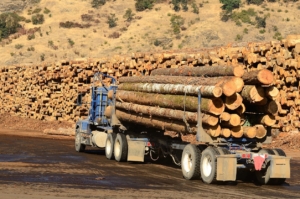North American Forests are Sustainable
Wood is a natural and renewable resource. Wood harvested from North American forests follows some of the world’s best forest management practices which have for decades provided net forest growth. Net forest growth refers to land which is reforested once the forests have been harvested; preventing a loss of forest acreage with the result being actual forest cover in North America is increasing.
Forest covers approximately 751 million acres, roughly a third of the landmass in the US1. 54% of the forest is publicly owned with the balance held in the hands of private landowners. Canada has 860 million acres of forest cover of which 94% is publicly owned and managed with the remaining 6% owned privately2.

Log truck delivers its load to a sawmill in Oregon
While harvesting wood occurs under different types of land ownership, forest management is governed by federal and state/provincial regulations that ensure that forest resources are well protected for the future.
The North American wood products industry is a world leader in sustainable forestry practices. Forest certification involves independent, third-party assessment that companies are operating in accordance with the principles of sustainable forest management that value the socio-economic and environmental contributions of forests.
The total size of managed forests in the US and Canada under the four internationally recognized forest certification programs used in North America is 500 million acres. This represents roughly half of the world’s certified forests3. North American forestry management practices ensure that deforestation and other threats to biodiversity do not occur4.
Wood is Nature’s Packaging.
Related Papers
- National Report on Sustainable Forests – 2010 (USDA June 2011)
- The Impact of Wood Use on North American Forests. (Educational content sponsored by reThink Wood)
- A Marketing Guide for Small and Medium Sized Primary Forest Products Processors (USDA June 2008)
- Value-Added Wood Products Marketing Guide for Manufacturers and Entrepreneurs (USDA January 2010)
- Wood and Carbon Footprint (Woodworks 2011)
Sources
- The 2003 and 2010 National Report on Sustainable Forests prepared by the United States Department of Agriculture (USDA) to fulfill the United States’ commitments to the Montréal Process Working Group on Criteria and Indicators for the Conservation and Sustainable Management of Temperate and Boreal Forests. The RPA Assessment, a nationwide forest inventory mandated under U.S. federal law to be undertaken every 10 years.An Assessment of Lawful Harvesting and Sustainability of U.S. Hardwood Exports. Seneca Creek Associates LLC, 2008
- The State of Canada’s Forests Annual Report 2014 Natural Resources Canada
- A Guide to World Resources 2000-2001: People and Ecosystems: United Nations Development Program, United Nations Environment Programme, World Bank and World Resources, September 2000. An independent peer-reviewed study commissioned by AHEC in 2008 from Seneca Creek Associates LLC entitled “An Assessment of Lawful Harvesting and Sustainability of U.S. Hardwood Exports”.
- Deforestation Canada, What are the Facts, Natural Resources Canada; State of the World’s Forests 2011, United Nations Food and Agriculture Organization (UNFAO, Canada’s rate of deforestation is [virtually] zero and has been for over two decades (United Nations FAO Global Forest Resources report issued in 2010).
